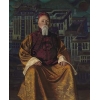|
 Nikolay Konstantinovich Roerich is one of the impressive figures in the
world of Russian symbolism and modern style, this is the legend that made the
paints and brushes serve for him and who won the hearts of people from all over
the world. Roerich became the famous traveler being a wonderful painter, archeologist,
writer and the philosopher mystic reflected in his paintings and the future
thereof. The inheritance issue by Roerich is the actual topic to discuss for 20
years already and is likely to last forever since a plenty of people concerned
are not willing to talk in public. And one of the disturbing questions is what
happened to the famous paintings and who owns them. Nikolay Konstantinovich Roerich is one of the impressive figures in the
world of Russian symbolism and modern style, this is the legend that made the
paints and brushes serve for him and who won the hearts of people from all over
the world. Roerich became the famous traveler being a wonderful painter, archeologist,
writer and the philosopher mystic reflected in his paintings and the future
thereof. The inheritance issue by Roerich is the actual topic to discuss for 20
years already and is likely to last forever since a plenty of people concerned
are not willing to talk in public. And one of the disturbing questions is what
happened to the famous paintings and who owns them.
All the events proceeded in the end of the '80s when Svyatoslav Nikolaevich
Roerich was about to move the artistic property of the family to the USSR from India.
The painter had all the reasons not to trust to the government of the country
where the part of the heritance of great painters was ransacked when the works
were brought to Moscow
in 1958 by Yuriy, the elder brother of the famous family of painters. The second
crucial factor was the global restructuring in the country which appeared to be
the treat for the legendary collections. And it was in 1990, when Svyatoslav granted
the artistic property of the his family to the public organization, the Soviet
Fund by Roerich, created in 1991 renamed to the International Center by Roerich
by his initiative. Though, those 288 paintings by Nikolay and Svyatoslav Roerich,
brought by the painter's son to the 100-year anniversary of his legendary
father and left it under the trust of the Ministry of Cultural Affairs of the
USSR, and then, later on in the year 1990 he included the part of it into his
will in favor of the International Center by Roerich and which are not granted
yet to the Public Museum named after N.K. Roerich.
And people frequently wonder where these paintings are actually and whether
they subsist in this world. And the real
mysticism works here since no one verification inspection meets the requirements
of impartiality, while there is a real mess in official documents. Thus, there are
two certificates registered under the number 54, as though executed at the State
Museum of Eastern Nations Art on the same date, as to March 12, 1993, that
reflect one and the same occasion, in particular, the transfer of 282 paintings
by Roerich from the temporary storage to the permanent place.
Which is exciting, both documents are authentic and every single one
appeared in the court proceedings. Another interesting fact is that the paintings
change their names in a
mysterious way. In particular, the painting called «Tibet»
by Nikolay Roerich turned into «Monastery» in 1937, and in the year 1939 it
appeared as «Himalayas» in the loggers. The issue
on where the paintings exist and whether the paintings kept in the State Museum
are authentic will come frequently and the reply is not likely received.
Nevertheless, let's come to the paintings which were found authentic at
the famous auction houses. Currently the greatest price for the works by Nilkolay
Roerich appeared to be «And appeared» which was sold in 1922 at the Sotheby's in
2007. The sale of this work of art evoked the real shock with the famous
collectors since by the posted price of 100-140 thousand pounds the painting
was sold for 1,756 million pounds ($3,62 million US dollars), 17 times higher
than the experts anticipated. A year before the painting «Lao-Cze» became the
most expensive lot at the Sotheby's in New
York in 1924 when it was sold for $2,2 million US
dollars, ten times higher than the experts predicted.
Svyatoslav
Roerich went by the way of his father and his work art called «Portrait of
Nikolay Roerich in the Tibet
attire» from 1933 was sold for $3 million US dollars at the Christie's on April
24, 2009. This painting is believed to be one of the substantial works in the
artistic heritance of the painter which shows respect to his father and
accentuates his unique style of portrait painting so much typical for the orthodox
icon painting. Svyatoslav marked in his article from 1942, that the
portrait-painter should transfer «the particular features and typical accents which
are most expressive and unique, that are worth memorizing, and either remove or
smooth the features that may draw attention away from the entire picture». That
was likely the factor why the paintings by Roerich are so highly demanded by the
collectors. Though, whatever the case, every painting by the Roerichs is the
unique masterpiece which is full of the profound philosophy.
|